To troubleshoot engine parts on a car, you will need: a portable lamp, a set of flat probes, a ruler, a caliper, a bore gauge, a micrometer, a scraper.

1. Clean the piston head from carbon deposits. If the piston has scuff marks, traces of burnout, deep scratches, cracks, replace the piston. Clean the grooves for the piston rings. It is convenient to do this with a piece of the old piston ring.

2. Clean the oil drain holes with a suitable piece of wire.

3. Check up backlashes between piston rings and flutes on the piston.
Nominal clearance, mm:
- 0.04-0.075 - upper piston compression ring 1;
- 0.03-0.065 - lower piston compression ring 2;
- 0.02-0.055 - oil scraper ring 3.
The maximum allowable clearance for all piston rings is 0.15 mm.
4. Piston ring gaps can be most accurately determined by measuring the rings and grooves on the piston. To do this, measure the thickness of the piston rings with a micrometer in several places along the circumference, then...
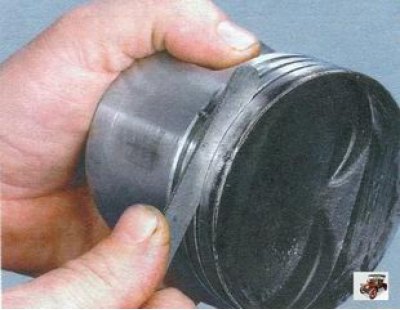
5.... using a set of feeler gauges, measure the width of the grooves also in several places along the circumference. Calculate Average Clearances (difference between piston ring thickness and groove width). If at least one of the gaps exceeds the maximum allowable, replace the piston with rings.
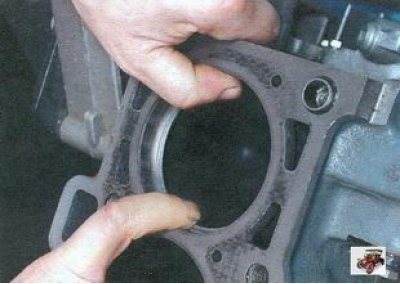
6. Measure backlashes in locks of piston rings, having inserted a piston ring into a special mandrel. If there is no mandrel, insert the piston ring into the cylinder in which it worked (or will it work if the ring is new), push the piston like a mandrel into the cylinder so that it is installed in the cylinder evenly, without distortions...
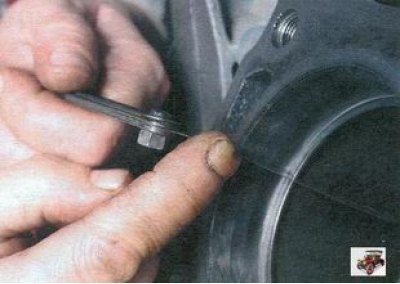
7.... and measure the gap in the piston ring lock with a feeler gauge. The nominal clearance of the piston ring should be 0.25-0.45 mm, the maximum allowable (as a result of wear) - 1.0 mm. If the piston ring clearance exceeds the limit, replace the piston ring.
8. If the piston ring gap is less than 0.25 mm, carefully grind off the ends of the piston ring with a needle file.
9. Check up backlashes between pistons and cylinders. The clearance is defined as the difference between the measured piston and cylinder diameters. The nominal gap is 0.025-0.045 mm, the maximum allowable gap is 0.15 mm. If the clearance between pistons and cylinders does not exceed 0.15 mm, pistons from subsequent classes can be selected so that the clearance is as close as possible to the nominal clearance. If the clearance between pistons and cylinders exceeds 0.15 mm, bore the cylinders and install pistons of the appropriate oversize. Measure the piston diameter at a distance of 55 mm from the bottom in a plane perpendicular to the piston pin.
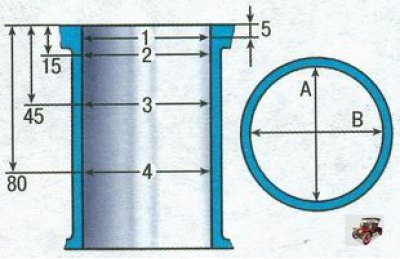
Pic. 4.6. Cylinder measuring points
10. Then measure the diameters of the engine cylinder in two perpendicular planes (pic. 4.6) (B - along, A - across the cylinder block) and four belts (1, 2, 3 and 4). To do this, you need a special device - a caliper.
11. When replacing parts of the connecting rod and piston group, it is necessary to select pistons for cylinders by class and one group by weight, as well as piston pins for pistons by class and connecting rods by weight. To match pistons to cylinders, calculate the gap between them. For the convenience of selecting pistons for cylinders, they are divided, depending on the diameters, into five classes through 0.01 mm: A, B, C, D, E (tab. 4.1).
Spare parts are supplied with pistons of nominal size of three classes: A, C, E and two repair sizes (1st repair size - increased by 0.4 mm, 2nd - by 0.8 mm).
By weight, the pistons are divided into three groups: normal, increased by 5 g and reduced by 5 g. Pistons of the same group must be installed on the engine.
For oversized pistons, spare parts are supplied with oversized rings increased by 0.4 and 0.8 mm. On the rings of the 1st repair size, a number is stamped «40», 2nd - «80».
Table 4.1. Nominal sizes of cylinders and pistons
| Mass of connecting rod heads, g | Marking | ||
| upper | lower | letter | paint |
| 184±2 188±2 192±2 | 489±3 495±3 501±3 489+3 495±3 501±3 489±3 495±3 501±3 | F L B X M IN C H G | Red Green Blue |

12. Designations of the class of cylinders are embossed on the bottom plane of the block (mating surface for oil sump) opposite each cylinder.
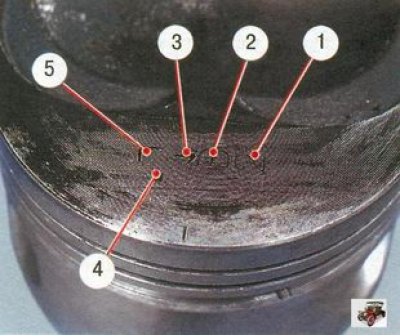
13. The following data is stamped on the piston bottom: 1 - piston class according to the pin hole; 2 - piston diameter class; 3 - an arrow showing the direction of installation of the piston; 4 - repair size (1st repair - triangle, 2nd repair - square); 5 - group by weight (normal - «G», increased by 5 g - «+», reduced by 5 g «-»).

14. Replace cracked piston pins. The piston pin should easily enter the piston with the force of the thumb. Insert the piston pin into the piston. If play is felt when rocking the piston pin, replace the piston. When replacing a piston, select a piston pin according to the class (tab. 4.2). Piston pins are divided by diameter into three classes (1st, 2nd, 3rd) through 0.004 mm. The class of the piston pin is marked on its end face with paint. The piston class on the finger is knocked out on the piston bottom, the connecting rod class on the finger is on the connecting rod cover.
15. Replace broken rings and oil ring expander.
16. Replace broken or cracked circlips holding piston pin. The ends of the retaining rings must be in the same plane. Replace bent piston rings.
17. Replace bent connecting rods. Replace the connecting rod if there are scores or deep scratches in the top head bushing. Replace the connecting rod if, during disassembly of the engine, it is found that the connecting rod bearings have turned in the connecting rod.
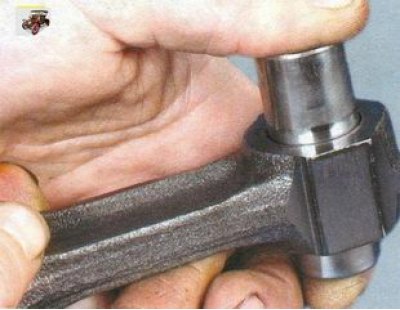
18. Insert a finger into the top head of a rod. If play is felt when the finger is wiggled, replace the connecting rod. Connecting rods with caps are divided into classes according to the mass of the upper and lower heads (tab. 4.3).

19. Connecting rods of the same class must be installed in the engine. The connecting rod is marked on its cover: 1 - connecting rod weight class (letter or paint); 2 - connecting rod class on the finger.
Table 4.3. Connecting rod class by mass of reapers and bottom heads
| Mass of connecting rod heads, g | Marking | ||
| upper | lower | letter | paint |
| 184±2 188±2 192±2 | 489±3 495±3 501±3 489+3 495±3 501±3 489±3 495±3 501±3 | F L B X M IN C H G | Red Green Blue |
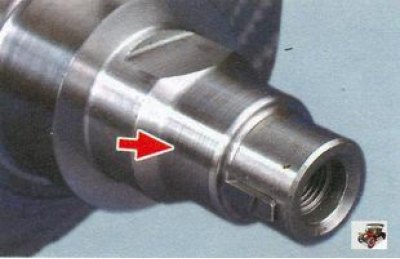
20. If there are deep scratches, scratches, nicks on the surfaces on which the seals work, the crankshaft must be replaced.

21. Measure the main and connecting rod journals of the crankshaft. Nominal diameters of crankshaft journals, mm:
- root necks - 50.799-50.819;
- crankpins - 47.830-47.850.
If the wear or ovality of the crankshaft journals exceeds 0.03 mm, they must be ground to the nearest repair size.
There are four repair sizes with a decrease in the diameter of the crankshaft journals, mm:
- the first - by 0.25;
- the second - by 0.5;
- the third - by 0.75;
- the fourth - by 1.00.
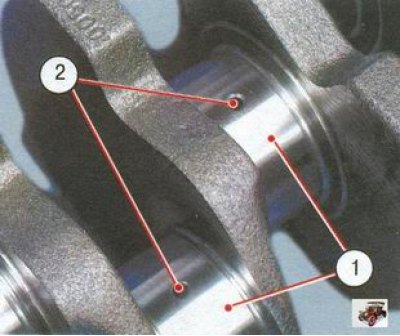
22. If there are minor scuffs, risks, scratches on the main and connecting rod journals 1, you need to grind them to the nearest repair size. This work is recommended to be carried out in a specialized car workshop. After grinding, polish the crankshaft journals and dull the sharp edges of the chamfers of the oil channels 2 with an abrasive cone. Wash the crankshaft and blow out the oil passages with compressed air. The ovality and taper of all crankshaft journals after grinding should not exceed 0.005 mm. After grinding the crankshaft journals, install the bushings of repair dimensions.

23. If there are scuffs, risks and delaminations on the working surfaces of the thrust half rings, replace the half rings. It is forbidden to carry out any fitting work on the half rings.

24. Measure the axial clearance of the crankshaft. To do this, install the crankshaft and thrust half rings in the cylinder block and tighten the bolts securing the main bearing caps (see «Engine Assembly»).

25. Install the indicator so that its leg rests against the crankshaft flange. Slide the crankshaft away from the indicator until it stops and set the indicator needle to zero. Move the crankshaft to the opposite side. The indicator will show the gap. The nominal axial clearance of the crankshaft is 0.06-0.26 mm, the maximum allowable is 0.35 mm. If the axial clearance of the crankshaft exceeds the maximum allowable, replace the thrust washers.
Spare parts are supplied with thrust semi-rings of the crankshaft in two sizes: nominal size - 2.31-2.36 mm and repair size (increased by 0.127 mm) - 2.437-2.487 mm.
26. Inspect the connecting rod and main bearings. Replace connecting rod and main bearings with cracks, scoring, chipping. It is forbidden to carry out any adjusting work on the connecting rod and main bearings.
Nominal thickness of connecting rod and main bearings, mm:
- indigenous liners - 1.824-1.831;
- connecting rod bearings - 1.723-1.730.
Connecting rod and main bearings are supplied in spare parts of four repair sizes, increased thickness, mm:
- the first - by 0.25;
- the second - by 0.50;
- the third - by 0.75;
- the fourth - by 1.00.
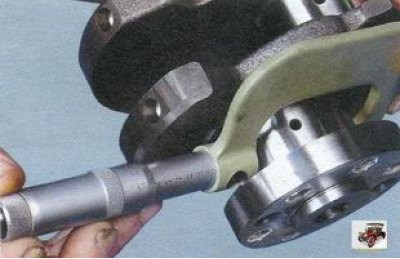
27. Check up backlashes between loose leaves of radical bearings and necks of a cranked shaft. This work is recommended to be carried out in a specialized car workshop. Measure the diameters of the journals and main bearings by installing the caps with liners on the block and tightening them to the appropriate torques. Calculate clearance. Clearances between bearings and crankshaft journals:
- main bearings (nominal 0.026-0.073 mm, maximum allowable 0.15 mm);
- connecting rod bearings (nominal 0.02-0.07 mm, maximum allowable 0.1 mm).
If the gap exceeds the maximum allowable, the crankshaft must be ground to the next repair size.
28. In a specialized auto repair shop, you can measure the runout of the crankshaft journals.
The runout of the crankshaft journals should be:
- main journals and seating surface for the oil pump drive gear no more than 0.03 mm;
- landing surface for the flywheel is not more than 0.04 mm;
- landing surface for pulleys and seals is not more than 0.05 mm.

29. Thoroughly clean and flush the crankshaft oil passages.

30. It is not recommended to press out the plugs yourself; for this, contact a specialized car repair shop.
31. Thoroughly clean the surfaces of the cylinder block from the remnants of old sealing gaskets. Carefully inspect the cylinder block. If cracks are found, the cylinder block must be replaced complete with main bearing caps.
32. Check up tightness of a jacket of cooling of the block of cylinders. To do this, plug the hole for the water pump (installing water pump with gasket) and pour antifreeze into the cooling jacket. If a leak is noticeable in any place, then the block is leaky and must be replaced.
33. Inspect the cylinders. If there are scratches, scuffs, shells and other defects on the cylinder mirror, bore the cylinders to the repair size (This work is recommended to be carried out by a specialist workshop) or replace the cylinder block. With various defects deeper than 0.8 mm, the cylinder block cannot be repaired and must be replaced.
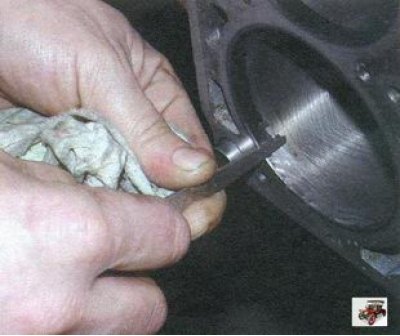
34. Clear a deposit in the top part of cylinders. If a belt has formed there due to cylinder wear, remove it with a scraper. Check the wear of the cylinders by measuring their diameters.
Table 4.2. Classes of piston pins, pistons and connecting rods
| Class | Diameter | Marking | ||
| finger | hole in piston and rod | finger | piston and connecting rod | |
| 1 2 3 | 21,970-21,974 21,974-21,978 21,978-21,982 | 21,982-21,986 21,986-21,990 21,990-21,994 | Blue Green Red | 1 2 3 |
